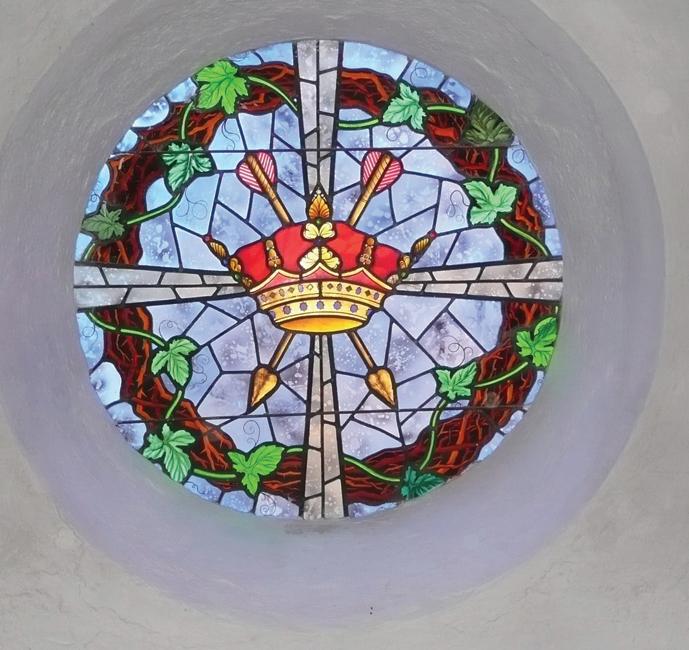
3 minute read
SAINT EDMUND KING AND MARTYR
Have you ever wondered, as I have, why St George, a foreigner who probably never even visited our shores, became the Patron Saint of England?
Apparently St George was declared a saint in AD 494 by Pope Gelasius but it was not until 1350 that he became the patron saint of England. However, it was reported that in the 12th century King Richard the Lionheart called on the help of St George before going to war during the Crusades.
Advertisement
King Edward III, who was the reigning monarch in England at that time, chose St George as the country’s patron saint as he was admired by many for his bravery in the face of terrible suffering.
Not to be forgotten, there is of course, also the legend that a knight named Sir George saved a princess by slaying a dragon.
So St. George became a symbol of courage in the face of adversity, as well as embodying the English ideals of honour, bravery and gallantry. But did you know that before St George, England had another Patron Saint – Edmund, King of Norfolk 855 AD and Suffolk 856 AD - was made a Saint towards the end of the 9th century and died in 869 AD.
An Anglo-Saxon prose writer AElfric (955-1025 AD) in his “Lives of the Saints” and a Benedictine Monk Abbo of Fleury (945-1004 AD) in his “The Passion of St Edmund” tell us that Edmund was an able and diligent king looking after his subjects with honesty and kindness at the same time dealing fairly but strongly with wrong doers.
In 865 AD the Danish Vikings invaded England under the leadership of a Dane either called Hinguar by AElfric, or Ivar by Abbo. The Vikings were a fearsome force going about the country ravaging the land, torturing and killing men, women and children. Hinguar then turned his attention to attack East Anglia.
It was here that Hinguar sent a message to Edmund offering to spare him if Edmund would share his wealth with him and bow in allegiance to him.
Throughout his reign as king of Norfolk and Suffolk, Edmund had won over the hearts of his subjects by his care of the poor and by his steady suppression of wrong doing. Even though he was being threatened with certain death, Edmund was not prepared to give up on his people or his faith in God.
But Edmund did not just decline Hinguar’s offer - in fact he said he would submit, but only if Hinguar first agreed to acknowledge the supremacy of God.
This response obviously did not please the Viking leader, who went ahead, sought out and captured Edmund. It is recorded that when Edmund stood before Hinguar, Edmund threw down his weapons thus imitating Christ’s example. You may remember that when Christ was arrested in the garden of Gethsemane He forbad Peter to fight with weapons. Edmund was tied to a tree and beaten. He was then shot with arrows as a sport and then finally beheaded. As AElfric says “Thus his blessed soul journeyed to Christ”.
If you are looking for a man of courage in the face of adversity, honour, bravery and gallantry one need to look no further than Saint Edmund. Not only that - he also lived and died fighting for England!
So why should the foregoing be of interest to the readers of the Stubbington November issue of the “Stubbington Choice”. Well Stubbington, which is part of the Church of England’s parish of Crofton, is blessed with having a church dedicated to St Edmund and November 20th is St Edmund’s Patronal Day. This year we will be celebrating his life at the Morning Service Sunday 26th November 09.30.
As always, you are more than welcome to come and join us. The church is on Lychgate Green off Marks Tey Road PO14 3HA.
Whilst there, take the opportunity to look at the round St Edmund’s window high up at the west end of the church. The Crown denotes Edmund’s Kingship, the Blue background his faithfulness to his people and the Arrows the means of his Death. The Crown of Thorns reminds us of Christ’s Crucifixion. The intertwined Vine growing through it represents the new life St Edmund brought to the spread of Christianity through his life.
We hope that the church, also known as Crofton Old Church, parts of which date back to the Domesday Book, will be a reminder of St Edmund our Patronal Saint, for many more generations to come.
Gary Willcocks Warden for St Edmund’s













